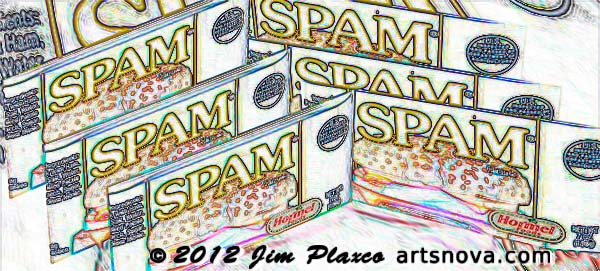Spam Spam Spam Spam Comments

Spam spam spam spam
A week ago I upgraded my blog's version of WordPress. A big downside of that upgrade was that a couple of "tricks" I had put in place to defeat the spambots were undone. As a consequence my inbox for moderating comments found itself filled with around a thousand comments. Unwilling to dig through a mountain of garbage I simply deleted everything. If I deleted your comment, my apologies. Earlier today I completed the modifications to my blog that will hopefully make me once more invisible to the spambots. Of course this doesn't stop those humans low enough to stoop to spamming but that's a volume I can deal with.
Now one of the goals of a blog is to attract comments but not all comments are created equal. All too many blogs allow spam comments advertising all kinds of garbage to be published. Keeping spammers at bay has led me to pursue several tactics. One that is invisible to the visitor are the WordPress "tricks" I mentioned previously. Another layer of defense is to use a captcha to keep robots out. I use a very simple captcha. While some captchas seem to have as their top priority keeping robots out – at the expense of also keeping people out as well, I've gone with a simple captcha that anyone should be able to read – even some bots. Another line of defense is to have moderation turned on. That means that no comment appears on my blog until I approve it (which can unfortunately sometimes lead to significant delays between the time that someone makes a comment and the time I actually approve the comment.) And of course there are always the anti-spam WordPress plugins.
Having had to deal with many comments over the years, based on my experience I have found that comments fall into four broad categories.
Category 1: The Blatant Spam Comment
These comments have nothing to do with the blog post and are simply a commercial directing readers to some web site to buy some product. I'm amazed that this class of comment is so popular because that popularity means that they work often enough to make it worth the spammers time and energy. These spam comments take three forms. First is the url the spammer enters into the address field; second is the link they include in the text of their comment; third is the sales pitch they make in the body of their comment.
Category 2: The Sneaky Spam Comment
These are comments that are little more than a line saying "great post" or "I love your blog" In other words the spammer forgoes the posting of a link and sales pitch in the body of the comment. The spam component is in the url they provide, like loweryourmortgage.dummy (I put in the .dummy part because only a dummy would follow a link like that). The publishing of such comments provides two benefits to the spammer. First there is the chance that someone will be dumb enough to click the link and visit the site. The second benefit is that the link becomes indexed by the search engines and potentially improves the spammer's search engine ranking.
Category 3: The Generic Comment
The only difference between this comment and the Category 2 Sneaky Spam Comment is the absence of a spam link. I take these short congratulatory comments as directed to me personally rather than as comments that others are meant to read. So while I smile and appreciate receiving these complimentary comments, I do not publish them on my blog because they do not provide original information that benefits the next reader.
Category 4: The Golden Comment
These are the rarest of comments. They are comments that add value to the post. They can be as simple as the asking of a relevant question, or an expansion on what I have written, or a reference to a source of relevant information on another web site. In short these are comments that leave the reader more enlightened.
Conclusion
So if you're visiting my blog and leave a simple compliment like "nice article", please don't be surprised if it is never published. While I do appreciate the feedback, I only publish those comments that leave the readers that follow more enlightened about the subject at hand.
Ad Astra, Jim
| Return to the Blog Index | This entry was posted on Tuesday, January 8th, 2013 at 5:54 pm and is filed under Computing, Odds and Ends.